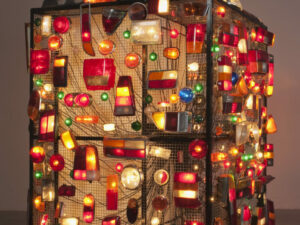“The Ballad of Sexual Dependency is the diary I let people read,” Nan Goldin once wrote. “The diary is my form of control over my life. It allows me to obsessively record every detail. It enables me to remember.” The title quotes The Threepenny Opera and it actually still comprises more than 700 colour photographs, running in sequences, each image present for three or four seconds, replaced seamlessly by another, with songs from opera, Top 40, downtown New Wave dance clubs and blues records playing alongside.
First exhibited in 1986, Goldin hyper-famous transgression charades represent the very first event supported by The Museum of Contemporary Photography at The Triennale di Milano. A dark amphitheatre safeguarding almost 700 snapshot-like portraits have been sequenced against an evocative music soundtrack. The Ballad of Sexual Dependency is a deeply personal narrative “ejection” poured into a multi-part slide projection with soundtrack that ranges from punk to opera. Images drown and surface, whilst music affect each single corner of real life. And from Charlotte Rae singing the title song to Petula Clark and Downtown, from Maria Callas’s Casta Diva to the Velvet Underground’s I’ll Be Your Mirror, from Dionne Warwick and Don’t Make Me Over to You Don’t Own Me, the music makes the sequence of photos of people stuck in a moment, as if they were glorifying a living instant.
Goldin began taking pictures when she was 18; sold only through a gallery as an art work, in the collection of museums, never available to the public except at film festivals or when a museum chooses to present it, “The Ballad of Sexual Dependency” is, Goldin affirmed, “the history of a re-created family” and the mission of her new family was to give itself over to “that part of your brain that is only satisfied by love, heroin, or chocolate”; to embrace what she called “a disbelief in the future”; to pursue an escape from the dependencies of ordinary life. In the main entrance of La Triennale di Milano – the very first ground-floor wing of the 1933 Palazzo dell’Arte – Goldin’s Ballad floats in darkness. An installation comprising a wooden arena – spotted by pale lights – offers audiences a video projected once per hour, introduced by a presentation and followed by an exhibition of printed materials and original posters from Goldin’s earliest performances in the pubs of New York city. François Hébel, curator, affirms that this exhibition passes through people with a deep poetry – a devastating melancholy. The Ballad evolves unceasingly, shaped by the extraordinary sensitivity of its author. The quest for love and passion, the despair and hope, is supported by a soundtrack which celebrates the vertigos of life.
Hébel states: “One needs to have seen this projection to understand how it was a liberating punch against the conformity of photography and how this remains one of the best diversions of the image in favour of expression and the memory of the soul.” In understanding how prescription and over-the-counter (artistic) medications can be used in the treatment of daily, mental sex addiction, it’s important to understand that Goldin’s scenarios gnaw at an important part of our lives, which can be a challenged from multiple point of views.
Ginevra Bria
At La Triennale di Milano until 26 November. For more information: www.triennale.org
Credits:
1. © Nan Goldin, Self-portrait in kimono with Brian, New York City, 1983.





